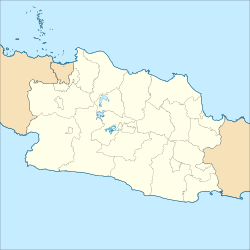Cipetir, Sukabumi
Appearance
Cipetir | |
|---|---|
Village | |
| Coordinates: 6°48′S 107°18′E / 6.8°S 107.3°E | |
| Country | Indonesia |
| Regency | Sukabumi |
| District | Kadudampit |
| Population (2010) | |
• Total | 5,716 |
Cipetir (pre-EYD spelling and Dutch: Tjipetir) is a village in Sukabumi, West Java, Indonesia. As of 2010, it has 5,716 inhabitants.[1]
The name comes from Sundanese, and literally means "Thunder River", from ci ("river") and petir ("thunder").
Plantation
[edit]
Cipetir was the site of a gutta-percha plantation in the 19th and early 20th century.
Marine debris consisting of blocks of gutta-percha, which is highly resistant to water corrosion, with the word "TJIPETIR" on them has been found on beaches throughout Europe. They are believed to be coming from one or more sunken ships from the early 1900s. The wreck of the Miyazaki Maru, sank in 1917, has been put forward as potential source of the blocks.[2][3]
Wikimedia Commons has media related to Cipetir rubber plantation.
References
[edit]- ^ Census 2010, Badan Pusat Statistik, Population_of_Indonesia_by_Village
- ^ Cacciottolo, Mario (1 December 2014). "Tjipetir mystery: Why are rubber-like blocks washing up on European beaches?". BBC News. Retrieved 1 December 2014.
- ^ David, Romain (2014-04-03). "Le mystère des "plaques de Tjipetir" ravive le fantôme du "Titanic"". Le Figaro.
External links
[edit]


